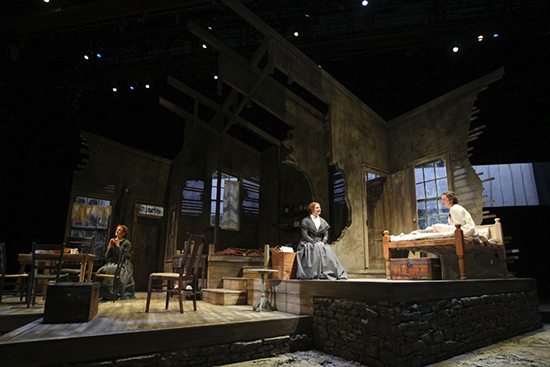Some Notes on Family Dysfunction and the Occult
I wore white gloves—maybe I’m imagining this—reading letters to and from the Fox sisters in the late 1840s, soon after the outbreak of ghostly “rapping” in the walls of their house in Hydesville, New York. Theirs was a local story with enormous cultural influence—on the burgeoning women’s suffrage movement, for example—and yet it remains a story clouded with exaggeration, fabrication, and error.
 |
| Rachel Rusch as Lizzie, Lanie MacEwan as Leah, and Annie Purcell as Maggie |
One of the University of Rochester librarians told me that many Modern Spiritualists have come to see these letters, handled them with reverence, and some have cried. As if communing with holy relics. I felt some of that power, but mostly I felt a rare and fragile link to the indelible lives of two young girls, long gone, caught up in the fabric of a story beyond their control.
The excerpt published in this issue of Blackbird includes the first few scenes of the play, when the Fox family moves into a decrepit small house in Hydesville, a hamlet—or a crossroads, really—roughly forty miles from the then–bustling metropolis of Rochester, New York.
Act 1 dramatizes the growing manifestation of haunting phenomena in the house, perhaps indistinguishable from an increasing unraveling of family dysfunction, all culminating in the now–famous night of March 31, 1848. This is the date Modern Spiritualists consider the birth of their religion, when they believe that “Charles B. Rosna,” the spirit of a murdered traveling salesman buried in the cellar of their house, opened a lane of communication between the living and the dead (to paraphrase Auden).
Act 2 begins weeks later with the arrival of the girls’ older sister Leah, a struggling single mother from Rochester. Word of the haunting has reached her and she’s come to investigate what’s “really” going on, the secrets and abuses of her own childhood resurgent in her mind. She doubts the veracity of the haunting, but she sees in the girls a potent emotional if not spiritual force, and the opportunity for a better life economically. The play ends with Leah removing the girls from their parents and the house in Hydesville, embarking on a journey that will take the newborn Spiritualist movement to Rochester, then Manhattan, and eventually around the world. ![]()